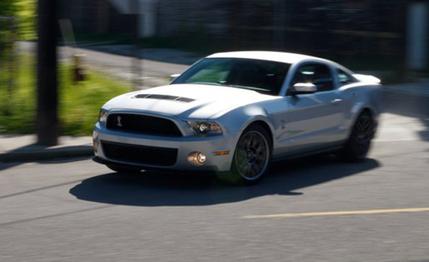
 Road Test
Road Test
No matter how good the Shelby GT500 has looked on paper, the car has always fallen short in reality, not unlike LeBron and the Cavs. Part of the reason could be its live rear axle, a component junked by virtually every carmaker decades ago, and rightly so—it’s awfully hard to get a car to handle and ride optimally without an independent rear suspension.
But more important, perhaps, is that the supercharged truck engine stuffed under the GT500’s hood added weight to the front end of a car that was already nose heavy. The last Shelby we tested was more than 300 pounds heavier than a GT, and almost all of those extra pounds were over the front axle. Much as we enjoyed the 2007 to 2010 Shelbys, we didn’t like the way they overworked their brakes or understeered. They liked entering corners about as much as a pig enjoys being measured for an open pit. Plus, their engines suffered from heat soak during track work and wouldn’t produce full power during lapping sessions.
About a year ago, a couple of Ford insiders told us that a fix was in the works for the Shelby’s recalcitrant behavior. “A lighter engine,” they murmured. When the 2011 Shelby GT500 was revealed at the Chicago auto show earlier this year, Jamal Hameedi, SVT chief nameplate engineer, and Hermann Salenbauch, director of advanced product creation and global performance vehicles, took us over to the car on the show floor and proudly lifted the hood. There, nestled in the engine bay, was an aluminum-block 5.4-liter V-8, topped by a Roots-type blower.
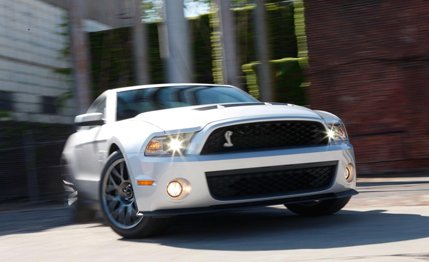

The engine is essentially a wet-sump evolution of the Ford GT’s (which was itself a dry-sump evolution of the SVT Mustang’s). The aluminum block is different, however: It features six-bolt, billet main bearing caps and Ford’s first use of “plasma transferred wire arc” liner coatings on the cylinder bores, which adds enough strength to get around using cast-iron liners and sounds awfully similar to what Mercedes-Benz started doing five years ago on its 6.2-liter AMG V-8. The GT500’s engine retains the same 90.2-millimeter bore and 105.8-mm stroke of the iron-block engine, as well as the 8.4:1 compression ratio. A larger, two-row intercooler is said to have 40 percent more cooling capacity than the single-row unit it replaces.
The new engine makes 550 horsepower at 6200 rpm, an improvement of 10 horses over the 2010 GT500. Peak torque remains unchanged at 510 pound-feet, but it’s delivered 250 revs lower, at 4250 rpm. Most important, the new engine shaves 102 pounds off the iron-block V-8’s weight.
Otherwise, the base 2011 GT500 is relatively unchanged compared with the 2010 model, except that it gets electric power assist for the steering instead of hydraulic boosting; even the spring rates are unchanged, though the new car is lighter than the old. Inside and out, it remains virtually the same, except there’s now an optional glass roof, standard high-intensity discharge headlamps, and a programmable key.
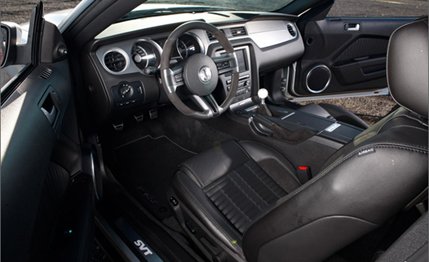

Also newsworthy for 2011 is the availability of an SVT Performance package ($3495). It features Goodyear’s latest Eagle F1 Supercar rubber, the G:2. The P265/40 front and P285/35 back tires mount on 19-inch front and 20-inch rear forged aluminum wheels, each one inch larger than the base GT500’s.
To match the tires, Ford engineers increased the front spring rate by 20.5 percent and the rear by 9.5 percent, while lowering the ride height by 0.4 and 0.3 inch, respectively, compared with the base GT500’s. The engineers also modified the shock valving for stiffer damping and added a new front underbody-closeout panel and a shorter, 3.73:1 final-drive ratio. Externally, cars with the Performance package get narrower body stripes than the base GT500’s. Our test car came without stripes—they’re a delete option, and that would be our choice because the car still looks brawny but a bit more understated.
Thanks to the new engine, the electric power steering, and the lighter wheels, the car we drove tipped our scales at 3751 pounds, 146 less than the last GT500 we tested. More important, the amount of weight over the front wheels has gone from 57.4 percent to 55.7 percent. This less porky GT500 also gets better EPA gas mileage—up from 14 mpg city and 22 mpg highway to 15 and 23—making it the first GT500 to avoid a gas-guzzler penalty.
The combination of less weight, more power, better tires, and a revised suspension turns the Shelby into the car it always should have been. At the test track, we recorded 0 to 60 mph in 4.1 seconds, 0 to 100 in 9.1 seconds, and the standing quarter-mile in 12.4 seconds at 117 mph. Our last 2010 test car ran those sprints in 4.5, 9.6, and 12.7 seconds, respectively. The 70-to-0 braking took 151 feet, an improvement from 165. Grip came in at an impressive 1.00 g, with far less understeer than the last car’s 0.91-g effort. Those numbers are right up with a Corvette Grand Sport’s and better overall than the last BMW M3 we tested.
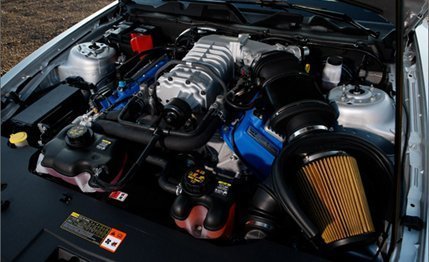

On the street, it’s now a much more coherent machine. The engine sounds sensational, with a malevolent snarl at high revs that’s enhanced by a muted whine from the supercharger. Power delivery is very linear, with meaningful thrust above 2000 rpm, and the shifter for the six-speed manual has short throws and a narrow gate with a positive, if somewhat notchy, action. Brake-pedal feel is superb and involving, but—despite being accurate and direct—the steering could use a little more weighting.


Still, this is the first GT500 that truly handles well. It turns in crisply and is satisfyingly neutral unless you take a 90-degree bend with the stability system turned off or the road is wet, in which case, the back end slides in a controllable manner that will impress your more juvenile friends. On dry roads, in third gear and beyond, the back end stays planted. Surprisingly, despite the antediluvian rear axle, it rides quite comfortably and isn’t upset by midcorner bumps.
The goodness doesn’t come cheap. The Shelby GT500’s base price is $49,495, which grew to $55,330 on our test vehicle with the addition of the SVT Performance package—a must-have in our minds—and the Electronics package (voice-activated navigation system, high-definition and satellite radio, and dual-zone electronic climate control). Fully loaded, the Shelby can reach $57,700, which is a lot of money for a Mustang.
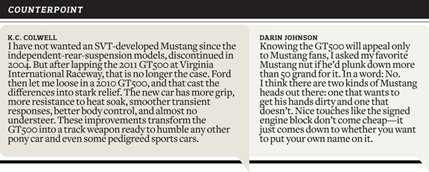

Then again, the Shelby’s only real competition comes from within its own ranks. The Shelby positively slaughters rival pony cars from Chevy and Dodge. A Corvette is a sports car and not directly comparable, no matter how often we do so. And while an M3 lines up on price and performance, that car plays to a markedly different audience.
Lurking in the background is another Ford Mustang that’s almost as fast, handles just as well, and costs a comforting 20 grand less. Unless you’re a complete Mustang nut who has to have the biggest of the breed in the garage, a GT—particularly now, with the new 412-hp, 5.0-liter V-8—will give you most of what the Shelby offers. It’s a bit like the Cavs: Was it really a good idea to spend all that money to get Shaq?